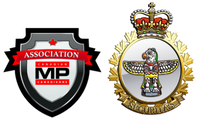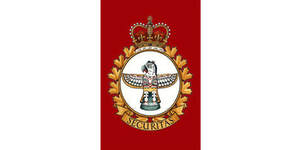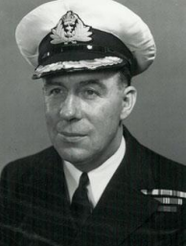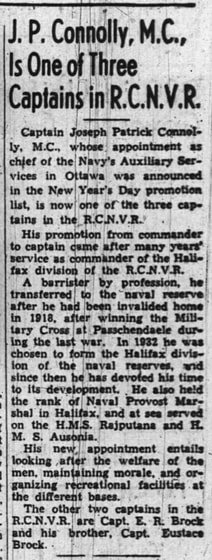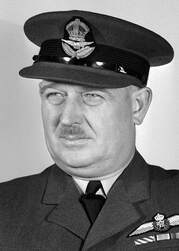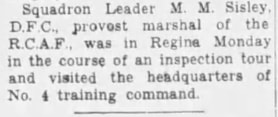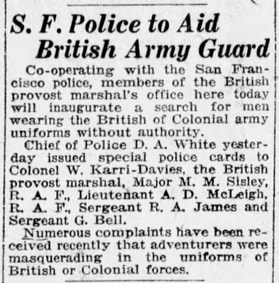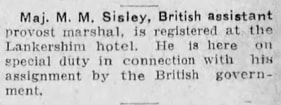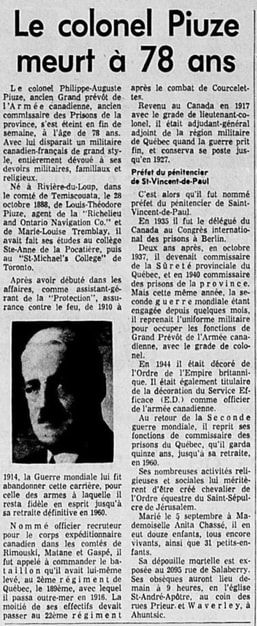Looking Back: The Military Police Branch Birthdate, 15 June 1940
By Lieutenant-Colonel Paul Thobo-Carlsen (Retired), CMPA Director of History & Heritage.
|
As the Military Police Branch celebrates its anniversary each June, it is appropriate to reflect on the significance of why 15 June 1940 was chosen as the official Branch birthdate. Military Police personnel who served back when we were known as the Security Branch will likely recall that 1 February 1968 was designated as the Branch's birthdate—the same day the unified Canadian Armed Forces came into being with the passage of the Canadian Forces Reorganization Act. The logic for choosing the original 1968 date was certainly sound. That was the day Canada's three armed services, and their individual Service Police organizations, ceased to exist—giving way to a unified military service with a single Military Police organization. What better date to celebrate our birth?
|
Security Branch flag – adopted in 1976.
Military Police Branch flag – 2000 to present. |
|
Several years after the Military Police Branch was renamed in 2000, it was discovered that Canadian Armed Forces' custom permitted Branches to link their founding to a formally established antecedent Corps or Branch as long as the lineage reflected continued and unbroken existence. Heritage experts from the Directorate of History and Heritage were of the opinion that our official lineage originated with the formation of the Canadian Provost Corps (CProC) on 15 June 1940, during the Second World War. Further confirmatory staff checks were conducted which led to a decision by the Canadian Forces Provost Marshal in January 2011 to adopt the 1940 date in order to more appropriately recognize the long and proud history of military policing in Canada.[1]
Although the Royal Canadian Navy and Royal Canadian Air Force had been quickly building their own service policing capabilities by June 1940, the CProC was the earliest comparable and clearly established service police organization to which the modern Military Police Branch could demonstrate direct lineage. Furthermore, while several sizable Canadian Military Police organizations had earlier existed during the First World War, all of these had been disbanded by mid-1920 which effectively prevented any claim of unbroken lineage back to that era.
General Order No. 140 of 1940 (reprinted at right) announcing the creation of the CProC shows that the enabling Privy Council Order (P.C. 67/3030) was not actually approved until 9 July 1940, although the effective date of the corps' creation was specified as 15 June.[2] This was very likely due to the huge number of war-related matters facing the Canadian government of the day, and the reality that bureaucracy is sometimes outpaced by military necessity. Considering that German troops had entered Paris, France on 14 June 1940, the government would have had many military decisions to make during this period. Department of National Defence documentation shows that by June 1940 Provost detachments were already operating at several military districts in Canada, as were some Detention Barrack staffs.[3] Furthermore, No. 1 Provost Company (RCMP) had been operating with the 1st Canadian Infantry Division in England since December 1939 and No. 2 Provost Company, fully formed by May 1940, had deployed overseas with the 2nd Canadian Infantry Division in early June 1940.[4]
|
G.O. 140 CALLING OUT OF TROOPS ON ACTIVE SERVICE—THE CANADIAN PROVOST CORPS, C.A.S.F Pursuant to Section 20 of the Militia Act, His Excellency the Governor-in-Council, names as a Corps of the Active Militia and under authority of Section 64 of the Militia Act places on Active Service: The Canadian Provost Corps, C.A.S.F. 2. The Corps shall be constituted as follows: (i) Corps Headquarters (ii) Staffs—Internment Camps (iii) Staffs—Detention Barracks (iv) Provost Companies 3. The Corps Headquarters shall consist of an Officer styled “Officer Administering Canadian Provost Corps, C.A.S.F.” and such additional personnel as may be authorized by the Minister. 4. The number of Staffs—Internment Camps; Staffs—Detention Barracks; and Provost Companies and the location thereof, shall be as from time to time authorized by the Minister. 5. The Home War Establishment of the Canadian Provost Corps, C.A.S.F. is hereby authorized. Copies will be distributed separately to all concerned. (Effective 15th June 1940) H.Q.S. 7236 P.C. 67/3030 of 9-7-40 Canada Gazette (1867-1946), Vol. 74, No. 4, 27 July 1940, pg 241.
|
The Military Police Branch originated on 15 June 1940 with the formation in the Canadian Army of 'The Canadian Provost Corps.'
A-AD-267-000/AF-001, The Insignia and Lineages of the Canadian Forces, Volume 1.
Canada's First Provost Marshals of the Second World War
With the founding of the CProC on 15 June 1940 one might expect that the Canadian Army was the first of the armed services to appoint a Provost Marshal during the Second World War. Curiously, this was not the case.
The Royal Canadian Navy (West Coast)
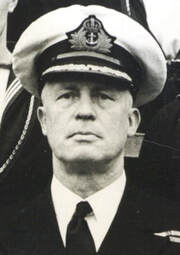 Russell P. Ponder, Naval Provost Marshal (Naden, Esquimalt BC)
Russell P. Ponder, Naval Provost Marshal (Naden, Esquimalt BC)
The RCN was the first service to appoint a Provost Marshal. However, instead of creating a single centralized post, separate Provost Marshals were established to support the West and East coasts fleets. Lieutenant-Commander Russell P. Ponder, Royal Canadian Naval Volunteer Reserve (RCNVR), was called to active service on 5 September 1939 and appointed as the Naval Provost Marshal at HMCS Naden (RCN Barracks) in Esquimalt, British Columbia.[5] Born in London, England, Ponder joined the Royal Navy Volunteer Reserve (RNVR) in 1905 at age 17. He later came to Canada and joined the British Columbia Provincial Police in 1912. The outbreak of war in August 1914 led to his call-up for service in the fledging Royal Canadian Navy, but in May 1915—by then a Chief Petty Officer—Ponder returned to London where he was commissioned into the RNVR. By early 1916 Lieutenant Ponder was serving on a gunboat on the Tigris River in Mesopotamia (now Iraq).
Upon demobilization in 1919 Ponder returned to Victoria, BC where he rejoining the Provincial Police and was also appointed as a Lieutenant in the RCNVR. By 1938 he had retired from the volunteer reserves, at the rank of Lieutenant-Commander, but continued to serve in the BC Provincial Police. The Second World War brought him out of military retirement and his appointment as Naval Provost Marshal on Canada's west coast allowed him to fuse his naval and policing skillsets together with good effect. On 15 December 1941 Ponder was granted acting Commander rank and he remained as Naval Provost Marshal until 27 October 1942 when he assumed other duties. Russell P. Ponder finally retired from the RCNVR on 29 March 1945 at the substantive rank of Commander. He retired from the BC Provincial Police on 31 December 1946 at the rank of Sergeant.
Upon demobilization in 1919 Ponder returned to Victoria, BC where he rejoining the Provincial Police and was also appointed as a Lieutenant in the RCNVR. By 1938 he had retired from the volunteer reserves, at the rank of Lieutenant-Commander, but continued to serve in the BC Provincial Police. The Second World War brought him out of military retirement and his appointment as Naval Provost Marshal on Canada's west coast allowed him to fuse his naval and policing skillsets together with good effect. On 15 December 1941 Ponder was granted acting Commander rank and he remained as Naval Provost Marshal until 27 October 1942 when he assumed other duties. Russell P. Ponder finally retired from the RCNVR on 29 March 1945 at the substantive rank of Commander. He retired from the BC Provincial Police on 31 December 1946 at the rank of Sergeant.
Upon demobilization in 1919 Ponder returned to Victoria, BC where he rejoining the Provincial Police and was also appointed as a Lieutenant in the RCNVR. By 1938 he had retired from the volunteer reserves, at the rank of Lieutenant-Commander, but continued to serve in the BC Provincial Police. The Second World War brought him out of military retirement and his appointment as Naval Provost Marshal on Canada's west coast allowed him to fuse his naval and policing skillsets together with good effect. On 15 December 1941 Ponder was granted acting Commander rank and he remained as Naval Provost Marshal until 27 October 1942 when he assumed other duties. Russell P. Ponder finally retired from the RCNVR on 29 March 1945 at the substantive rank of Commander. He retired from the BC Provincial Police on 31 December 1946 at the rank of Sergeant.
The Royal Canadian Air Force
Canadian Army (Canadian Active Service Force)
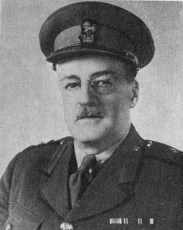 Phillipe-Auguste Piuze, Provost Marshal (Canadian Army) Phillipe-Auguste Piuze, Provost Marshal (Canadian Army)
Colonel Phillipe-Auguste Piuze was appointed as Provost Marshal and Officer Administering the Canadian Provost Corps, in September 1940. Born in Fraserville QC (near Rivière-du-Loup) in 1888, he was an insurance broker and militia Major in the Canadian Field Artillery when the First World War broke out. In February 1916 he was appointed to raise and command the 189th Battalion, Canadian Expeditionary Force, at the rank of Lieutenant-Colonel. He served most of the war on training and administrative duties with this and other infantry units in England, with short periods spent in France. Piuze returned to Canada in 1917 to take up staff duties with Military District No. 5 in Quebec City and his First World War service concluded with command of the 1st Depot Battalion, 2nd Quebec Regiment.
Lieutenant-Colonel Piuze transferred to the Permanent Force and served until 1927 as the Assistant Adjutant and Quartermaster-General for MD 5. He then left the army to work in the civilian correctional system and by 1935 was the head of the Saint-Vincent-de-Paul Penitentiary in Laval QC. In 1937, he was appointed as Commissioner of the Sûreté provinciale du Québec (equivalent to today's Director of the Sûreté du Québec), a position he held until May 1940 when he became the Commissioner of Prisons for the Province of Québec. He rejoined the Canadian Army on 29 August 1940, at the rank of Colonel, to take up duties as its Provost Marshal and Officer Administering the Canadian Provost Corps. Colonel Piuze retired from the army in September 1943, on medical grounds, and resumed his old position as Commissioner of Prisons until his final retirement in 1960. He was replaced as Provost Marshal by Colonel George Thomas Goad. For his wartime service, Colonel Piuze was invested into the Order of the British Empire.
|
La Press (Montreal, Quebec), Monday, 11 September 1967, page 75.[11]
|
----------
Notes:
1. Correspondence between DHH and CF MP Gp staffs in 2007 provided the earliest indication that 15 June 1940 was an appropriate Branch birthdate. In October 2010, confirmatory staff checks were initiated by the Branch Chief Warrant Officer (CWO R.P. Day) to ensure that neither of the other former services had a stronger claim to have been the first to formally establish a service policing organization. In January 2011, after DHH heritage experts had provided their final advice on the matter, the Canadian Force Provost Marshal (Colonel T.D. Grubb) approved the new anniversary date of 15 June.
2. Canada. The Canada Gazette (1867-1946), Vol. 74, No. 4 (27 July 1940), 241. Available online at: www.collectionscanada.gc.ca/databases/canada-gazette/001060-119.01-e.php?image_id_nbr=323163&document_id_nbr=8486&f=g&PHPSESSID=jg46tnrjkas3r1hrnj1v224dgnfteh9r1k6cuii3dk59jtpum9j0.
3. Canada. DND. Minister of National Defence to His Excellency the Governor-in-Council, HQS 7236, f.d. 968 (Org 2c), 29 June 1940,
4. P.A.H. Dupille, ed., The Canadian Provost Corps Silver Jubilee: 1940- 1965 (Ottawa: Director of Security/Canadian Forces Headquarters, 1965), 14 and 31.
5. F.V. Langstaff, H.M.C.S. Naden Naval Barracks, 2nd Ed (Victoria: Self-published, 1957), 55-56.
6. Canada. DND. The Canadian Navy List, Corrected to 30 November 1939 (Ottawa: J.P Patenaude, I.S.O. Kings Printer, 1940), 39. Available online at:
www.canadiana.ca/view/oocihm.8_06834_73/1?r=0&s=1.
7. J.P. Connolly's First World War personnel file can be viewed online from Library and Archives Canada at: www.bac-lac.gc.ca/eng/discover/military-heritage/first-world-war/personnel-records/Pages/item.aspx?IdNumber=112696.
8, R.H. Caldwell, "The VE Day Riots in Halifax, 7-8 May 1945," The Northern Mariner/Le Marin du nord, X, No, 1 (January 2000), 11-12.
9. Ronald J. Donovan and David V. McElrea, A History of the Royal Canadian Air Force Police and Security Services (Renfrew ON: General Store Publishing House, 2008), 6. The RCAF's first Provost Officer was Flying Officer G.H. Jerome, formerly of the Ontario Provincial Police.
10. For more information about Max Sisley and his two bothers in the Royal Flying Corps, see: malverncollegiate.com/decades/1903-1939/three-brothers-join-the-royal-flying-corps/.
11. "Le colonel Piuze meurt à 78 ans," La Press (Montreal, Quebec), September 11, 1967, 75. Available online at: numerique.banq.qc.ca/patrimoine/details/52327/2698859.
Notes:
1. Correspondence between DHH and CF MP Gp staffs in 2007 provided the earliest indication that 15 June 1940 was an appropriate Branch birthdate. In October 2010, confirmatory staff checks were initiated by the Branch Chief Warrant Officer (CWO R.P. Day) to ensure that neither of the other former services had a stronger claim to have been the first to formally establish a service policing organization. In January 2011, after DHH heritage experts had provided their final advice on the matter, the Canadian Force Provost Marshal (Colonel T.D. Grubb) approved the new anniversary date of 15 June.
2. Canada. The Canada Gazette (1867-1946), Vol. 74, No. 4 (27 July 1940), 241. Available online at: www.collectionscanada.gc.ca/databases/canada-gazette/001060-119.01-e.php?image_id_nbr=323163&document_id_nbr=8486&f=g&PHPSESSID=jg46tnrjkas3r1hrnj1v224dgnfteh9r1k6cuii3dk59jtpum9j0.
3. Canada. DND. Minister of National Defence to His Excellency the Governor-in-Council, HQS 7236, f.d. 968 (Org 2c), 29 June 1940,
4. P.A.H. Dupille, ed., The Canadian Provost Corps Silver Jubilee: 1940- 1965 (Ottawa: Director of Security/Canadian Forces Headquarters, 1965), 14 and 31.
5. F.V. Langstaff, H.M.C.S. Naden Naval Barracks, 2nd Ed (Victoria: Self-published, 1957), 55-56.
6. Canada. DND. The Canadian Navy List, Corrected to 30 November 1939 (Ottawa: J.P Patenaude, I.S.O. Kings Printer, 1940), 39. Available online at:
www.canadiana.ca/view/oocihm.8_06834_73/1?r=0&s=1.
7. J.P. Connolly's First World War personnel file can be viewed online from Library and Archives Canada at: www.bac-lac.gc.ca/eng/discover/military-heritage/first-world-war/personnel-records/Pages/item.aspx?IdNumber=112696.
8, R.H. Caldwell, "The VE Day Riots in Halifax, 7-8 May 1945," The Northern Mariner/Le Marin du nord, X, No, 1 (January 2000), 11-12.
9. Ronald J. Donovan and David V. McElrea, A History of the Royal Canadian Air Force Police and Security Services (Renfrew ON: General Store Publishing House, 2008), 6. The RCAF's first Provost Officer was Flying Officer G.H. Jerome, formerly of the Ontario Provincial Police.
10. For more information about Max Sisley and his two bothers in the Royal Flying Corps, see: malverncollegiate.com/decades/1903-1939/three-brothers-join-the-royal-flying-corps/.
11. "Le colonel Piuze meurt à 78 ans," La Press (Montreal, Quebec), September 11, 1967, 75. Available online at: numerique.banq.qc.ca/patrimoine/details/52327/2698859.
